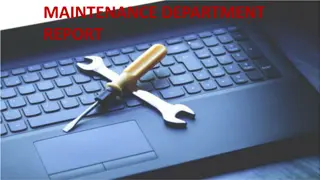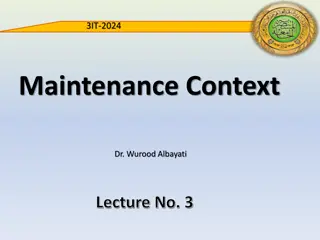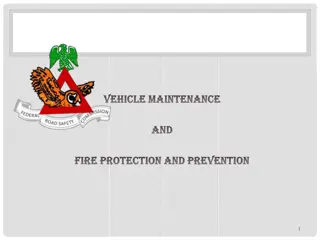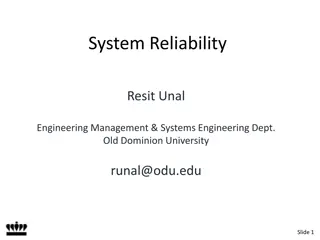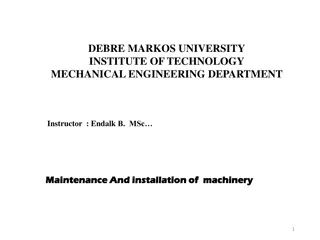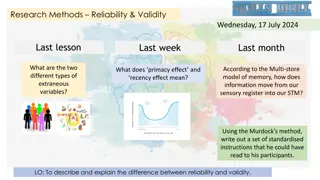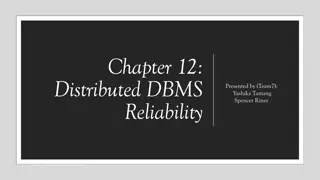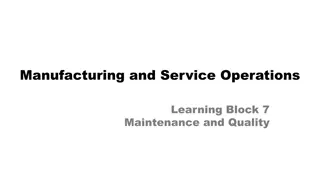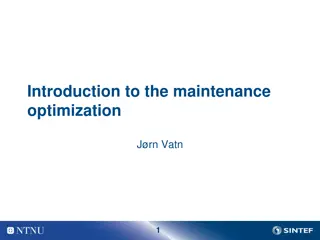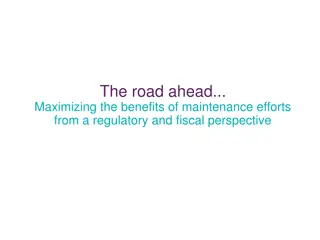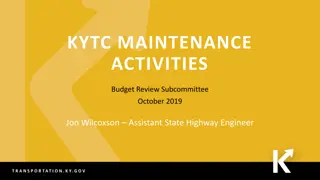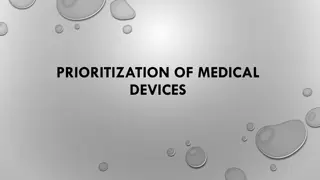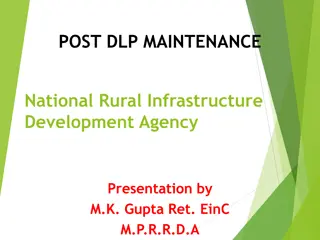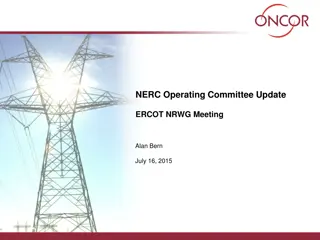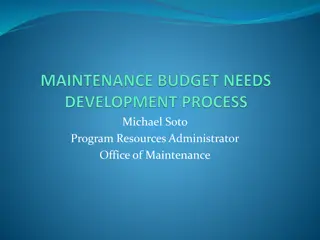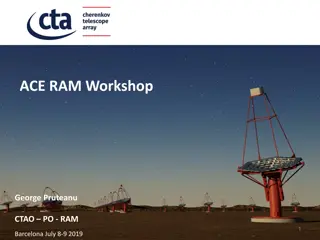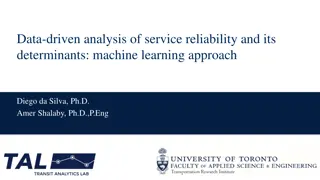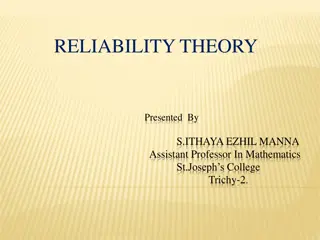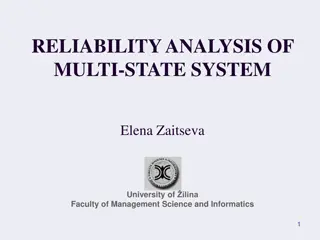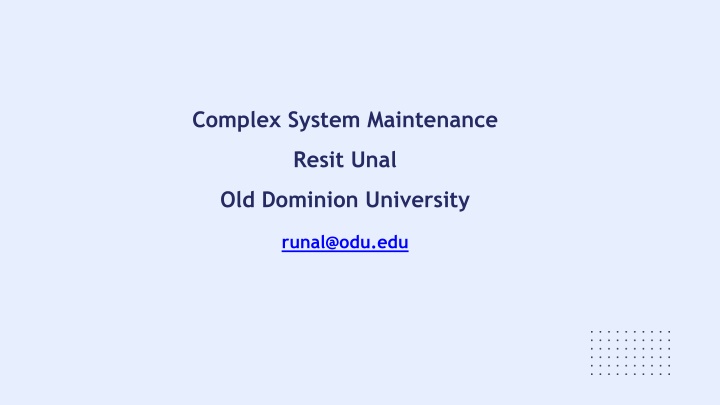
Reliability and Maintenance Practices in Complex Systems
Reliability in complex systems is crucial for optimal performance and uptime. Understanding failure patterns like the bathtub curve can help in defining appropriate maintenance strategies. Different types of maintenance, such as preventive and repair, play a key role in reducing failures and ensuring system availability. While traditional maintenance practices have been based on known models, recent studies suggest that random failures in complex systems may not adhere to such patterns. Exploring these concepts can enhance system reliability and operational efficiency.
Download Presentation

Please find below an Image/Link to download the presentation.
The content on the website is provided AS IS for your information and personal use only. It may not be sold, licensed, or shared on other websites without obtaining consent from the author. If you encounter any issues during the download, it is possible that the publisher has removed the file from their server.
You are allowed to download the files provided on this website for personal or commercial use, subject to the condition that they are used lawfully. All files are the property of their respective owners.
The content on the website is provided AS IS for your information and personal use only. It may not be sold, licensed, or shared on other websites without obtaining consent from the author.
E N D
Presentation Transcript
Complex System Maintenance Resit Unal Old Dominion University runal@odu.edu
Defining Reliability Reliability is the probability that a system will perform as anticipated under given operating conditions. It can predict the probability that a system will operate for a specified # of hours or a certain average time between failures.
Availability System/subsystem failures interrupt availability and operations. Consequences can be costly and may be critical; Operational, safety. Patterns of failures are typically described by the well-known bathtub curve:
Failure Patterns: Bathtub Curve Random Increasing 1st a period of decreasing failures (usually for new equipment), then a period of random failures followed by increasing failures due to wear.
Constant Failure Rate: Exponential Distribution 1. Failures occur at random intervals 2. Failure rate stays constant (time independent, no memory) Wear Burn-in CONSTANT FAILURE RATE (CFR) (t) (t) t EXPONENTIAL
Time Dependent Failure Rate Weibull Distribution: Burn-in and Wear out m < 1 Decreasing failure rate (Burn-in) WEIBULL DISTRIBUTION ? ? f(t) = ? (? )?_1? m > 1 Increasing failure rate (wear-out) m = Shape parameter = Scale parameter
Maintenance Maintenance is carried out to reduce failures and ensure availability. It may be preventive (PM) and/or repair (RM) after equipment failure. Traditionally the type of maintenance has been based on the bathtub curve.
Random failures It can be shown that PM has no effect on random failures in improving reliability, in fact PM may increase failures. Random failures are not age related. Recent studies reveal that complex system/subsystem failures do not follow the bathtub curve. They are more likely to suffer from random failures.
Failure patterns and distributions (Airline Study) 68% 4 % A D 2 % 7% E B 5 % C 14 % F Age Related: 11 % Random: 89 % Engine overhauls (PM) had little or no effect on Reliability and Safety
Failure patterns and distributions (SUBMEEP Study) 7% 2 % A D 9 % 9% E B 17 % C 56 % F Random: 72 % Age Related: 28 %
Failure Patterns for Complex Systems These studies led to the rise of Reliability Centered Maintenance. Complex systems tend to have an initial phase of high failures for new equipment, followed by random failures with no wear out.
Complex System Modifications / Upgrades Before Initially high failures, then random failure pattern. Not age related. Complex systems are more likely to suffer from random failures. After
Predictive or on-condition maintenance Such awareness has led some to abandon preventive maintenance (it has its place for equipment/components in identified wear out phases). The question is then, what needs to be done to ensure availability, safety. Repair (CM) is to be considered only for non-critical items. Predictive, On-Condition Maintenance utilized. Reliability Centered Maintenance (RCM).
Potential failures and On-Condition Maintenance Even though not age related, most failure modes give some warning that they are about to occur. If evidence can be found that something is about to fail, action may be taken to prevent and avoid consequences. On-Condition/Predictive maintenance tasks may be used to detect potential failures. P-F Curve.
P F Curve Potential Failure (Identify) Failure starts P Condition P-F Interval Failure F Time On condition tasks must be carried out at intervals less than the P-F interval
Recent Literature Power System Reliability and Maintenance Evolution: A Critical Review & Future Perspectives, M.S. Alvarez-Alvarado et al. (2022) Paper presents a comprehensive review of advances in maintenance strategies and system reliability for power systems (PS). It details existing approaches for PS maintenance planning, and provides definitions, models, methods, and maintenance policies. 286 References provided.
Recent Literature Continued Preventive, Corrective, Predictive, Condition Based & Asset Maintenances are discussed. Predictive Maintenance and RCM focus on most essential functions Condition Based Maintenance (CBM) monitors the health of the component, detect consequences (P-F Curve). CBM does not consider identifying optimal maintenance strategies in real time. Maintenance evolved into Asset Management. It consists in determining the best moment to maintain assets based on operating data. Reliability Based Smart Maintenance (RBSM) model.
Conclusions Accepting failures. Most failures are random, not wear related. Impact PM. Determine important failures, what, how & consequences. Impact CM. One can not maintain one s way to reliability. R Centered Design (RCD). Good maintenance programs are not cost, they save resources. Preventive, Corrective, Predictive, Condition Based and Asset Maintenance.
References 1. NASA Reliability Centered Maintenance Guide. 2. NAVSEA Reliability Centered Maintenance Handbook 3. Reliability Centered Maintenance, J. Moubrey (1977), Industrial Press. 4. 9 Principles of a modern preventive maintenance program, E. Hupje, https://roadtoreliability.com/reliability- centered-maintenance-principles/ 5. Power System Reliability and Maintenance Evolution: A Critical Review and Future Perspectives, Alvarez-Alvarado, M. S., et al. (2022), https://ieeexplore.ieee.org/stamp/stamp.jsp?arnumber=9768823 6. Optimal dynamic imperfect preventive maintenance of wind turbines based on general renewal processes, Wang, J., et al. (2020). International Journal of Production Research 58(22): 6791-6810. 7. Optimization of high-level preventive maintenance scheduling for high-speed trains, Lin, B., et al. (2019). Reliability Engineering & System Safety 183: 261-275. 8. Optimal preventive maintenance of wind turbine components with imperfect continuous condition monitoring, Raza, A. and V. Ulansky (2019). Energies 12(19): 3801. 9. Condition-based maintenance strategy for vehicles using hidden Markov models, Kamlu, S. and V. Laxmi (2019). Advances in Mechanical Engineering 11(1): 1687814018806380. 10. Hidden Markov models for wind farm power output, Bhaumik, D., et al. (2018). IEEE Transactions on Sustainable Energy 10(2): 533-539.

